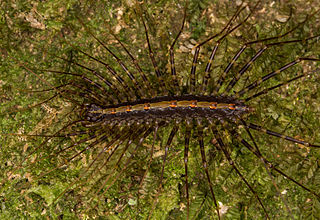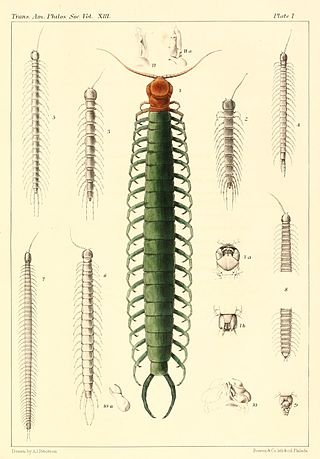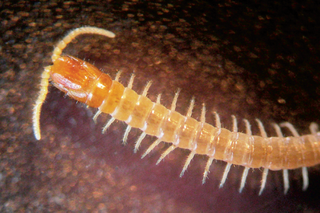
Ralph Vary Chamberlin was an American biologist, ethnographer, and historian from Salt Lake City, Utah. He was a faculty member of the University of Utah for over 25 years, where he helped establish the School of Medicine and served as its first dean, and later became head of the zoology department. He also taught at Brigham Young University and the University of Pennsylvania, and worked for over a decade at the Museum of Comparative Zoology at Harvard University, where he described species from around the world.

Lithobius is a large genus of centipedes in the family Lithobiidae, commonly called stone centipedes, common centipedes or brown centipedes.

Tantilla is a large genus of harmless New World snakes in the family Colubridae. The genus includes 66 species, which are commonly known as centipede snakes, black-headed snakes, and flathead snakes.
Vaine Wilton Ivie was an American arachnologist, who described hundreds of new species and many new genera of spiders, both under his own name and in collaboration with Ralph Vary Chamberlin. He was employed by the American Museum of Natural History in New York. He also was a supporter of the Technocracy movement.

Scutigeridae is a family of centipedes that are known as house centipedes. It includes most of the species of house centipedes, including Scutigera coleoptrata and Allothereua maculata.

Richard Lawrence Hoffman was an American zoologist known as an international expert on millipedes, and a leading authority on the natural history of Virginia and the Appalachian Mountains. He was a biology professor at Virginia's Radford College for almost thirty years, and curator of invertebrates at the Virginia Museum of Natural History for another twenty years. He co-founded the Virginia Natural History Society, described over 400 species of millipedes, and produced more than 480 scientific publications. He is commemorated in the scientific and/or common names of over 30 animal species, including the valley and ridge salamander and Hoffman's dwarf centipede.

Geophilus is a large, heterogeneous genus of soil centipedes in the family Geophilidae largely considered to be synonymous with Brachygeophilus. It is a mostly holarctic genus characterized by a claw-shaped ultimate pretarsus, anterior porefields, complete or nearly complete coxo-pleural sutures at the prosternum, and incomplete chitin-lines. Centipedes in this genus range from 1 cm to 8 cm in length. The generic name first appeared in Brewster's Edinburgh Encyclopaedia in 1814 as Geophilus electricus.

Pselliodidae is a family of small centipedes, identical and closely related to house centipedes.

Scolopocryptops is a genus of bark centipedes in the family Scolopocryptopidae. There are over 20 described species in Scolopocryptops.

Strigamia is a genus of soil centipedes in the family Linotaeniidae. Members of this family can be identified by their anteriorly tapering bodies, the extra claw on the forcipules, scattered coxal pores, and the distinctly swollen ultimate legs of the males. There are at least 50 described species in Strigamia. Centipedes in this genus can reach 15 cm in length and can have as few as 31 pairs of legs or as many as 83 leg pairs. The species S. hoffmani is notable for its small size as well as for a small number of legs. Other species with notably few legs include S. sibirica and S. lutea.

Hemiscolopendra is a genus of bark centipedes in the family Scolopendridae. There are about six described species in Hemiscolopendra, found in North, Central, and South America.

Tygarrup is a genus of centipedes in the family Mecistocephalidae, found mainly in southeast Asia and from the Seychelles to Hawaii. Although species in this genus can have either 43 or 45 leg-bearing segments, most of these species have 45 leg pairs. An undescribed Tygarrup species found in the Andaman Islands has 43 leg pairs. Centipedes in this genus range from 2 cm to 6 cm in length. Tygarrup javanicus is one of the smallest of the mecistocephalid species and has become an invasive in greenhouses in Europe.
Geophilus cayugae is a species of soil centipede in the family Geophilidae found in New York, Virginia, and North Carolina. It grows up to 68 millimeters in length, though it averages 25–40, has 57–65 leg pairs in males and 63–67 in females, and is bright whitish yellow in color. G. cayugae can be identified by its well-developed paxilli, weakly consolidated sacculi, and concealed prebasal plate combined with lack of consolidated prebasal areas. It's found beneath rocks and other debris in high elevation montane regions.
Geophilus varians is a species of soil centipede in the family Geophilidae found in North America, particularly from South Carolina to Indiana, Ohio, Pennsylvania, and Virginia. It grows up to 40 millimeters, though it averages 30-35, ranges in color from light faded orange to yellow or whitish yellow with a deeper and brighter head, and has 53-59 leg pairs in males and 55-61 in females, as well as a complete lack of consolidated paxilli and sacculi, concealed prebasal plate, and unusually long ultimate legs.
Mecistocephalus is a genus of centipedes in the family Mecistocephalidae. It was described by British entomologist George Newport in 1843.

Australobius is a genus of centipedes in the family Lithobiidae. It was described by American biologist Ralph Vary Chamberlin in 1920.
Mecistocephalus consocius is a species of centipede in the Mecistocephalidae family. It was described in 1944 by American myriapodologist Ralph Vary Chamberlin.
Mecistocephalus hebrides is a species of centipede in the Mecistocephalidae family. It was described in 1944 by American myriapodologist Ralph Vary Chamberlin.
Mecistocephalus manokwarius is a species of centipede in the Mecistocephalidae family. It was described in 1944 by American myriapodologist Ralph Vary Chamberlin. This species is brown, has 49 pairs of legs, and can reach 44 mm in length.
Mecistocephalus tsenapus is a species of centipede in the Mecistocephalidae family. It was described in 1944 by American myriapodologist Ralph Vary Chamberlin. This species is light brown, has 49 pairs of legs, and can reach 16 mm in length.











